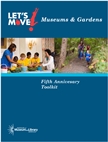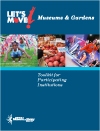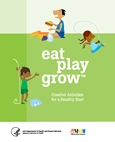
Priority #1: Eat healthy, get active exhibitsMuseums and gardens will commit to offering interactive experiences that promote healthy eating and physical activity. Ideas for interactive exhibits:
Create exhibits, web experiences or apps that utilize technology to encourage physical activity in ways that are fun and interactive. Priority #2: Learning about Healthy Choices through afterschool, summer and other programsProgramming includes healthy food choices and physical activity with emphasis on afterschool, summer, and school-based programs. Ideas for programs:
|
Toolkit for Participating Institutions (PDF, 266 KB) |
Priority #3: Healthy food service
Museums and gardens that offer food service will already offer or will change their menu to offer food options that reflect healthy choices (for example, the Centers for Disease Control guidance on procurement (PDF, 668 KB), pages 19 – 21).
Ideas for food service:
- Offer and promote healthy choices for all ages.
- Cultivate organic food/vegetable gardens, provide assistance for school and community gardens and offer related programs.
- Provide space for local farmers to sell fruits and vegetables. Museums and gardens connect families to farmers through programs.
- Offer and promote healthy foods; provide only healthy foods in classes, programs or camps.
- Encourage food service providers to develop healthy choices that are appealing to children and young people.
Priority #4: Learning about healthy food choices and physical activity using food service operation
Museums and gardens that offer food service will incorporate interpretation about healthy food choices.
Ideas for learning:
- Create exhibits that help families learn the difference between advertising for healthy and unhealthy food.
- Develop programs or exhibits that help families learn the difference between healthy and unhealthy choices and the impact those choices can make.
- Have MyPlate resources available and visible in food service areas.
- Host cooking demonstrations using healthy food choices.
- Serve food from your vegetable garden and include signage in the food service area about the health benefits of cooking with food from the garden.
- Develop signage for the food service area with nutrition information or tips on how much food is needed to get energy for specific activities.


